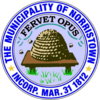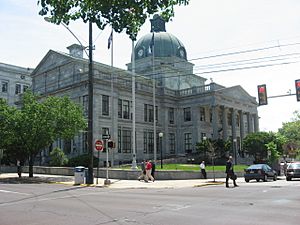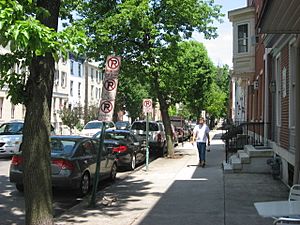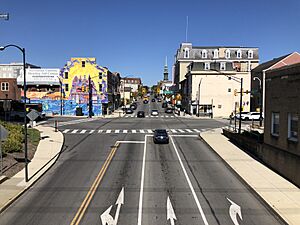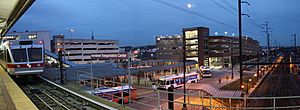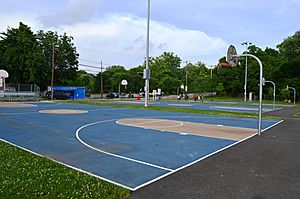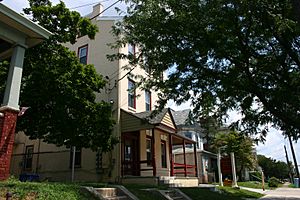Norristown, Pennsylvania facts for kids
Quick facts for kids
Norristown, Pennsylvania
|
|||
|---|---|---|---|
|
Home rule municipality
|
|||
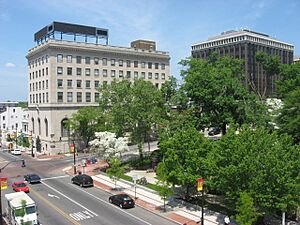
Main & Swede Streets May 2011
|
|||
|
|||
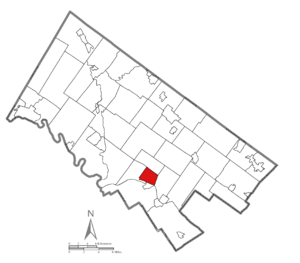
Location of Norristown in Montgomery County, Pennsylvania
|
|||
| Country | United States | ||
| State | Pennsylvania | ||
| County | Montgomery | ||
| Settled | 1682 | ||
| Borough | 1812 | ||
| Municipality | 1986 | ||
| Government | |||
| • Type | Council–manager | ||
| Area | |||
| • Total | 3.60 sq mi (9.33 km2) | ||
| • Land | 3.52 sq mi (9.10 km2) | ||
| • Water | 0.09 sq mi (0.23 km2) | ||
| Elevation | 135 ft (41 m) | ||
| Population
(2020)
|
|||
| • Total | 35,748 | ||
| • Density | 10,170.13/sq mi (3,926.44/km2) | ||
| Demonym(s) | Norristonians | ||
| Time zone | UTC-5 (EST) | ||
| • Summer (DST) | UTC-4 (EDT) | ||
| ZIP Codes |
19401, 19403-19409, 19487-19489
|
||
| Area codes | 610 and 484 | ||
| FIPS code | 42-54656 | ||
Norristown is a town in Pennsylvania, United States. It's the main town of Montgomery County. Norristown is located near the Schuylkill River, about 6 miles (9.7 km) from Philadelphia.
In 2020, about 35,748 people lived there. This makes Norristown the fourth largest town in Montgomery County. It's also the second largest borough (a type of town) in all of Pennsylvania.
Contents
History of Norristown
Norristown was first owned by the family of Isaac Norris. In 1704, he bought the land for a very low price. Later, in 1712, he built a gristmill there. A gristmill is a place where grain is ground into flour.
Norristown became the county seat (the main town for government) in 1784. It officially became a borough in 1812. At that time, only about 500 people lived there.
Growth and Change
After the American Civil War, Norristown grew very quickly. By 1900, its population was over 22,000 people. In 1940, it had about 38,000 residents. It was known as the most populated independent borough in the United States.
Norristown was a busy center for factories, shops, banks, and government. Many people worked in breweries, cigar factories, and textile mills. The downtown area had large stores and theaters. People could find everything they needed without leaving town.
At first, most people were from England, Germany, Scotland, the Netherlands, and Sweden. Later, many people from Ireland and Italy moved to Norristown.
After World War II, new shopping malls opened in nearby towns like King of Prussia. This caused the downtown area of Norristown to become less busy. Many factories also closed or moved away.
Geography and Climate
Norristown is in southeastern Pennsylvania. It's about 6 miles (9.7 km) northwest of Philadelphia. The town covers about 3.5 square miles (9.1 km²) of land. It sits along the Schuylkill River.
Two smaller streams, Stony Creek and Saw Mill Run, flow through the town and into the Schuylkill River. Norristown is generally hilly, especially near the downtown area.
Neighborhoods
Norristown has four main areas:
- The West End
- The East End
- The North End
- The Downtown area
It shares borders with West Norriton, East Norriton, and Plymouth townships. It also borders the borough of Bridgeport.
Weather in Norristown
Norristown has a humid subtropical climate. This means it has hot, humid summers and mild winters. Sometimes, it can get very hot or very cold.
| Climate data for Norristown, Pennsylvania (1991–2020 normals, extremes 1951–present) | |||||||||||||
|---|---|---|---|---|---|---|---|---|---|---|---|---|---|
| Month | Jan | Feb | Mar | Apr | May | Jun | Jul | Aug | Sep | Oct | Nov | Dec | Year |
| Record high °F (°C) | 76 (24) |
78 (26) |
84 (29) |
98 (37) |
98 (37) |
100 (38) |
108 (42) |
106 (41) |
102 (39) |
92 (33) |
85 (29) |
76 (24) |
108 (42) |
| Mean daily maximum °F (°C) | 41.7 (5.4) |
43.5 (6.4) |
52.1 (11.2) |
64.8 (18.2) |
74.8 (23.8) |
84.0 (28.9) |
88.8 (31.6) |
86.5 (30.3) |
80.0 (26.7) |
68.4 (20.2) |
56.8 (13.8) |
46.3 (7.9) |
65.6 (18.7) |
| Daily mean °F (°C) | 32.1 (0.1) |
34.1 (1.2) |
41.8 (5.4) |
53.1 (11.7) |
63.4 (17.4) |
73.0 (22.8) |
77.7 (25.4) |
75.9 (24.4) |
68.8 (20.4) |
56.5 (13.6) |
45.9 (7.7) |
37.3 (2.9) |
55.0 (12.8) |
| Mean daily minimum °F (°C) | 22.6 (−5.2) |
24.7 (−4.1) |
31.6 (−0.2) |
41.5 (5.3) |
52.1 (11.2) |
62.0 (16.7) |
66.6 (19.2) |
65.2 (18.4) |
57.6 (14.2) |
44.6 (7.0) |
35.1 (1.7) |
28.3 (−2.1) |
44.3 (6.8) |
| Record low °F (°C) | −12 (−24) |
−5 (−21) |
8 (−13) |
15 (−9) |
29 (−2) |
41 (5) |
48 (9) |
40 (4) |
35 (2) |
26 (−3) |
14 (−10) |
−10 (−23) |
−12 (−24) |
| Average precipitation inches (mm) | 3.66 (93) |
2.98 (76) |
4.41 (112) |
3.90 (99) |
4.25 (108) |
4.20 (107) |
4.70 (119) |
4.98 (126) |
4.91 (125) |
4.32 (110) |
3.61 (92) |
4.73 (120) |
50.65 (1,287) |
| Average snowfall inches (cm) | 6.8 (17) |
10.9 (28) |
3.0 (7.6) |
0.2 (0.51) |
0.0 (0.0) |
0.0 (0.0) |
0.0 (0.0) |
0.0 (0.0) |
0.0 (0.0) |
0.1 (0.25) |
0.1 (0.25) |
4.2 (11) |
25.3 (64) |
| Average precipitation days (≥ 0.01 in) | 11.0 | 9.4 | 11.1 | 12.8 | 14.1 | 11.9 | 10.7 | 10.4 | 8.9 | 11.2 | 9.3 | 10.5 | 131.3 |
| Average snowy days (≥ 0.1 in) | 3.3 | 2.9 | 1.6 | 0.1 | 0.0 | 0.0 | 0.0 | 0.0 | 0.0 | 0.1 | 0.1 | 1.4 | 9.5 |
| Source: NOAA | |||||||||||||
People of Norristown
| Historical population | |||
|---|---|---|---|
| Census | Pop. | %± | |
| 1820 | 827 | — | |
| 1830 | 1,089 | 31.7% | |
| 1840 | 2,937 | 169.7% | |
| 1850 | 6,024 | 105.1% | |
| 1860 | 8,848 | 46.9% | |
| 1870 | 10,753 | 21.5% | |
| 1880 | 13,063 | 21.5% | |
| 1890 | 19,791 | 51.5% | |
| 1900 | 22,265 | 12.5% | |
| 1910 | 27,875 | 25.2% | |
| 1920 | 32,319 | 15.9% | |
| 1930 | 35,853 | 10.9% | |
| 1940 | 38,181 | 6.5% | |
| 1950 | 38,126 | −0.1% | |
| 1960 | 38,925 | 2.1% | |
| 1970 | 38,169 | −1.9% | |
| 1980 | 34,684 | −9.1% | |
| 1990 | 30,749 | −11.3% | |
| 2000 | 31,282 | 1.7% | |
| 2010 | 34,324 | 9.7% | |
| 2020 | 35,748 | 4.1% | |
| Sources: | |||
In 2019, Norristown had about 34,341 people. The population has stayed about the same since 2010.
The people living in Norristown come from many different backgrounds. About 37.2% are Black or African American, 27.9% are White (not Hispanic), and 27.1% are Hispanic. About 6.4% are from two or more races.
There are about 11,963 households in Norristown. Many of these are families. The average household has about 2.79 people.
The average age of people in Norristown is 31.2 years old. About 26.2% of the people are under 18.
Most adults (about 76%) have finished high school. About 16.7% have a college degree or higher.
Economy and Jobs
Norristown's economy is mostly based on government, healthcare, and legal services. The government of Montgomery County is the biggest employer in the town.
Other important employers include the Pennsylvania Department of Environmental Protection (DEP) and the Norristown Area School District. These places provide many jobs for the community.
Transportation and Utilities
Norristown has many roads, with about 56 miles (90 km) of public roads. Some major roads like Main Street and Airy Street run through the downtown area. These roads connect to larger highways like I-476 and the Pennsylvania Turnpike.
US 202 is a main road that goes north and south through Norristown. It connects the town to other county seats like Doylestown.
Norristown Transportation Center
Norristown has a big transportation hub called the Norristown Transportation Center (NTC). This is where many different ways to travel come together.
SEPTA (Southeastern Pennsylvania Transportation Authority) runs:
- Many bus routes
- The Norristown High Speed Line (a fast train to 69th Street Transportation Center)
- A Regional Rail line (the Manayunk/Norristown Line to Center City Philadelphia)
The NTC also has a large parking garage for commuters. The Schuylkill River Trail, a path for walking and biking, also goes through the NTC. Soon, the Chester Valley Trail will also connect here.
Town Services
Electricity and natural gas in Norristown are provided by PECO Energy Company. Water is supplied by Pennsylvania American Water. The town also has its own system for sewer services and trash collection.
Media and Culture
The local newspaper for Norristown is The Times Herald. It prints seven days a week and covers news for most of Montgomery County. It was started a long time ago, in 1799.
Arts and Entertainment
Norristown has two performing arts centers:
- The Montgomery County Cultural Center
- Centre Theatre
It also has a professional theater company called Theatre Horizon. These theaters are part of Norristown Arts Hill, an area downtown with theaters, art galleries, and businesses.
Town Improvements
Over the years, Norristown has seen many new buildings and improvements. One Montgomery Plaza is a tall, 10-story office building downtown. Other new office buildings have also been built or updated.
Many new homes, like apartments and townhouses, have been built in the East End.
Two new parking garages were built downtown to help with parking. The town has also improved its streets with new lights, trees, and sidewalks.
A big project called the Lafayette Street Extension Project has improved road access to downtown Norristown. This project helps connect the town better to other areas and major highways.
Education in Norristown
Norristown Area School District is the local school district for Norristown.
There are also several Catholic schools in and around Norristown:
- St. Francis of Assisi School is in Norristown.
- Visitation B.V.M. School is nearby in West Norriton Township.
- Holy Rosary Regional Catholic School is in Plymouth Meeting.
- Mother Teresa Regional Catholic School is in King of Prussia.
Some of these Catholic schools were formed by combining smaller schools.
Places to Visit
Norristown has several interesting places to visit:
- Elmwood Park Zoo - A great place to see animals.
- Norristown Farm Park - A large park with trails and open spaces.
- Norristown State Hospital - A historic hospital.
- Norristown Transportation Center - The main hub for buses and trains.
- Schuylkill River Trail - A popular path for walking and biking along the river.
- Selma Mansion - A historic old house.
- Thaddeus Lowe House - The home of a famous Civil War inventor.
Famous People from Norristown
Many well-known people have connections to Norristown, including:
- Nia Ali - An Olympic track and field athlete.
- Geno Auriemma - A famous women's basketball coach.
- Maria Bello - An actress known for shows like ER.
- Peter Boyle - An actor from Everybody Loves Raymond.
- Tommy Lasorda - A legendary baseball manager for the Los Angeles Dodgers.
- Mike Piazza - A Baseball Hall of Fame catcher for the New York Mets.
- Art Spiegelman - A famous cartoonist who wrote Maus.
- Jerry Spinelli - A popular author of children's books.
Sister Cities
Norristown has "sister city" relationships with towns in other countries. This helps build friendships and cultural exchange.
 Ronse, Belgium
Ronse, Belgium Anzin, France
Anzin, France M'saken, Tunisia
M'saken, Tunisia Montella, Italy
Montella, Italy
See also
 In Spanish: Norristown para niños
In Spanish: Norristown para niños



